- 您的位置:
- 标准下载网 >>
- 标准分类 >>
- 国家标准(GB) >>
- GB/T 11197-2003 海上船舶无线电通话标准用语
标准号:
GB/T 11197-2003
标准名称:
海上船舶无线电通话标准用语
标准类别:
国家标准(GB)
标准状态:
现行-
发布日期:
2003-03-12 -
实施日期:
2003-09-01 出版语种:
简体中文下载格式:
.rar.pdf下载大小:
3.98 MB
替代情况:
GB/T 11197-1989采标情况:
IMO A.918(22):2001
点击下载
标准简介:
标准下载解压密码:www.bzxz.net
本标准规定了海上船舶通话联络所使用的通话程序、船舶对外和对内用语。本标准适用于海上航行、停泊和作业的一切船舶、设施以及有关的港口和搜救部门等。 GB/T 11197-2003 海上船舶无线电通话标准用语 GB/T11197-2003
部分标准内容:
GB/T 11197—2003
本标准修改采用国际海事组织(IM0)2001年11月29日通过的A.918(22)号大会决议《1M0)标准航海通信用语》。根据(:13/T1.1一2000的编写要求,增加了第1章范围和第2章规范性引用文件。本标推自第3章起全部中英文对照。本标准代替GB/T11197-·1939海上船帕无线电通话标准用语》,本标与原标准相比、增加了许多航海新技术的内容。
本标准的附录A是规范性附求。
本标准由中华人民共和函交通部提出本标准由交通部通信导航标推化技术委员会归口。本标准起草单位:交通部上海船舶运输科学研究所,交通部科学研究院。本标唯主要足草人:邱民、林青葛龙报、金胜利,本标摊于 1989 年首饮发布。
GB/T 11197-2003
IMO前言
闪为船一岸、岸一船,船一船以及船舶内部的航海安全通情必须准确、简洁和明了,避免模糊和销误,所以就需要使所使用的语言标准化,这对于不断增加的国际航行船舶的船员米说,是非常重要的,由于他们使用各种不同的语言所带来的迹信问题会与起误解,以而导致船舶、船上人员以及环境造成危害。
197年,在海上安全委员会第27次会议上,讨论研究了语告困难的间题,决定将英语作为航海的共同语言。因此.编制了标准航海英语(Standard Marine Navigatione」Vocabulary+SMNV)\,并于1977年批准采用,于t985年进行了修订。1992年,在海上安全委员会第60次会议上,考虑到现代航海的发展并应涵盖所有主要的与安全有关的几语通信,指示航行安全小组委员会编制更广泛的标准化的安全语言以取代1985年意订后的标淮航海英语
1997年,在海上安全委员会第68次会议上,批准广航行安全小组委员会编制的标准航海通信用语(StatidlerdMarineComnunicationPhranes,SMCP)》草案,随后,该草案经过国际间的试用后,在航行安全小组委员会的第6次会议上进行修订,并参照收到的评议油海上安全委员会第7微会议进行了最所考虑。标准航海通信用语》已于2m01年11月被第22届IM0人会批准,并作为A.918(223号尺会决设
根据~1978年海员培训、发证和值班标准国际公约》1995年修订本(STCW78/95),对500总吨或以上船朗负责航行值班的驾驶发证时,要求其具有理解和使用标谁航海通信用语的能力D
1范围
海上船舶无线电通话标准用语
本标推规定了海1.船舶通话联络所使用的通话程序、船舶对外和对内用语。GB/T 111972003
本标推适用十海上航行、停泊和作业的一切船舶、设施以及有关的港口和搜教部门等。2规范性引用文件
下列文件中的条款通过本标准的引用而度为本标准的条款。凡是注日期的引用文件,其随后所有的修改单(不包括勘误的内容)或修订版均不适用于本标准,然而鼓励根据本标准达成协议的各方研究是否可使用这些文件的最新版本。凡是不注日期的引用文件,其最新版本适用于本标准。IMO海1周语参考手册
ITU无线电规则
IM0)搜救手册1993年
IMO国际航空及海上搜救于册1998年IMOIMDGCODE国际海上危险货物运输规则1994年IMOSTCW海员培训、发证和值班标准国际公约1978年IMOSOLAS国际海上人命安全公约1974年IMOCOLREG国际海上避硅规则
3总则
GENERAL
3. 1程序
Procedure
当有必要指明打算使用1MO标准航海通信用语时,应发出以下信文:When it is necessary to indicate that the IMO SMCP are to beused,the following messiagemaybescnt.:
“请使用 TMO 标准航海通信用语。\\Please usr IMO Standard Marine Communication Phreses.\“我将使用TMO标准航海通信用语,n\I will use IMO Standerd Marine Communication Phirases, \3.2拼法
Spelling
3.2.1字母拼法
Spelling of letters
当使用对外通信拼法时,只能使用下述讲读丧。见表1,表2。When spelling is necessary.only the fullawing spelling table should be used :GB/T 11197—2003
Lerter
识别码
Charlie
Foxtrot
Iot el
Fuli et
3.2.2数字拼法
Spelling of digits arnd numbers少量数字的发音与-·般英语相比略有变化表1
Letter
识别码
Nev ember
Que bee
Si etra
Uniform
Vietar
Whisky
Yankee
A few digits and numbers have a modified pronunciation comparcd to gcncral Eglish :表2
Numher
信文标识
Messagemarkers
Spellirg
severl
thousamd
Prrnciatian
TOUSAND
在岸一和船一过信中或一般的无线电通信中,可使用下述八个信文标识(可参见 5.1.6“交通管理系统(VTS)标准用语”中的“信文标识应用”。In shore to-ship and ship to shore communicarion or radin comtnunicatian in gcncral, the follewing eight Messagc Markors may be used (also sec\Applicalion of Message Markers\, given in PART2
5, l. G \Vessel Traffic Serviee (VTS) Standurl Phrilses\).指示
Instruction
Advice
Warning
Information
Question
Answer
Request
Intention
3.4回答
Responses
对问题的回答是肯定的,应说“是的”,然后是适当的完整用语,3.4.1
When the answer to d question is in the affirmative, say:*Yes....\followed by the appropriate phrase in full3.4.2对间题的回答是否定的,应说“不”,然后是适当的完整用语。When the answer to a question is in the negative,say:\No,... \-followed by the appropriate phrase in full.3.4.3对需求的信息不能立即提供,可说:“请稍等\,随后不久进行发送。When the information rcquested is not irnmecliately available,say:GB/T11197—2003
\Stand by\-followed by the time interval within which the inlormation will be available.3.4.4不能得到需求的信息,可说:没有信息”,When the information requested cannot be obtained, say\No information\.
3.4.5当由交管站、海军船舶或其他权威人士给出指示(INSTRUCTION)或建议(ADVICE)时,给予肯定的回答,则说:\我将/能.”,随后是完龄的指示或建议。是否定的回答,则说“我将不/不能...….”.随后是完整的指示或建议.Whet an INS'r'RUCTION (e.g, by a VTS Station.naval vessel or other fully authorized personnel) or an ADVICE is given,respand if in the affirmativc:\l will/can ...\... followcd by the instruction or advice in full; and,if in the negative,respond;\I will not/cannot...\-followed by the instruction or advice in full.例如:“建议。不得超越你北面的船。”Fxample:ADVICE. Do not avertakc the vessel Narth of you. \回答:\我不会超越我北面的船。”Rrspond:\I will ot vertake the vessel tu the North of me.\3
GE/T 11197—2003
在对外通信和船谢内部通信中,应答命令和回答特别重要的间题时,应使用标准用语中的语句3.4.6
Responses to urders and answers to questicns of sperial importanre both in external and on-board corimunication are given in wording in the phiascs conceined.3.5退险/紧急/安全信文
Distress , urgency and safety signaks3.5.1 MAYDAY用于发布通险信文。MAYDAY to be uscd to announce a distress message.3.5.2PA.V-PAN用于发布紧急信文。PA.-PAN to be used to announce an urgency message.3.5.3SECURITE用于发布安全信文。SECURITE to be usel to announce a afety messagc.3.6标准组织用语
Standard organizational phrases3.61“你收听(我)的声音怎样!\\Haw da you read(ric)?*
3.6.1.1“我收听你的声音..
\I rcad you ...\
很差/1信号强度为1即极弱)
bad/ane with signal slrengtl one很弱/2信号强度为2(即很弱)
poor/twrs with signal strength twc还好/3信号强度为3(即还好)
fair/three with signal strcngth three较好/4信号强度为4(即较好)
good/four with signal strength four很好/5信号强度为5(即很好)
(i. e. barely perceptible)
(i.e.weak)
(i. e. fairly gaad)
(i.e. gaod)www.bzxz.net
uxcellent/fivewith signal strength five(i, e, very good)当建议保持在渠个VTF频道/额率上时,说.“请在VHF....频道...频率上守听”3.6.2
When it is advisable to remain on a VHFchannel/frequency+ say:\Stand by on VHF channel ... /frequency ...\3.6.2.1当同意保持在指定的VHF频道/频率上接收时,说“在VHF....赖道....频率守听”When it is accepted to remain an ihe VHF channel/frequency indicated,say:'Standing by on VHF channel ... /frequency ... \.3.6.3当建议转到另一VHF频道/频率时.说.请转到VHF.频道/..*.频率”。“请试VHF...频道..赖率”。
When it is advisable to changc to another VHF channel/frequent:y, say :\Advisc( you) change tr, VHF channel -.. /frequency ... \.\Advise(you) try VHF channcl ... /frequency... \当同意转到某VHF频道/频率接收时,说.“转到VHF...频道/..频率”3.6.3.1
When the chaiging of a VHF channel/frequency is acrepted,say:“Changing to VHF channel .../frequency++.\3.7改正
Corrections
当信文出现错误时,说;\.错误”,随后说“改正...”加上信文正确部分。When a mistake is made in a tnessage.say:\... istake\-followed by thc word:\Correction...plus the correcred part of the message.例如;“我现在的速度为14节,错误。改正,我现在的速度为12节,士二节,”Example:\My present speed is l4 knots-nistake.Correction,niy present speed is t2,onc-two,knots.3. 8 准备
Readiness
“我谁备还没准备好接收你的信文”。\I atn/I n nnt ready lo receive yrur message\3. 9重复
Repetition
GB/T 11197—2003
如果认为信文的某部分非常重要,为确保无误,可说“重复…”随后是信文的相应部分。3.9. 1
If any part of the message is considered sullicicently impnriant to nced safeguarding,say:\Repeat ... \ -followed by the corresponding part of the message.例如:“我的吃水为12.6,重复,十二点六米。\“不得追越一重复一不得追越”。Example:\My draft is 12. 6 repeat one-two dccimal 6 mctres. \\Do nat overtake-repeat-do not overtake.\3.9.2
如果信息没有确切听到,说:“请再说一遍。”When a message is not properly hcardsay:\Sayagain(plase),\
3.10数字
Numbers
数字逐位读出:
150应诺作:\二五0″
2.5应读作“二点五”
Numbers are to be spoken in separate digits:\(One-five-zera\for l50
\Two decimal five\ or
\Two jointfive\for2.5
注,注意!当读能角即舵令时,应按以下示例:读:15
或20等:
Nufe: Aitenlion! When rudder angles.e.g.in wheet orders.aregiven,say:\Fiftenn\ for 15 0r
\Twenty\for 20,etc.
Positions
GB/T11197—2003
3.11.1在使用经、纬度时,应以度、分(如果需要,可以用分的小数)来表示,并应标出北纬或南纬;东经或西经。
When latitude and longitude are used, these shall be expressed in degrers and minutes(anddecimals of minutc if necessary),Norih or South uf the Equator and East or West of Grecnrich
例如:“警告,在北纬15°34°.西经61\29”处有危捡沉船。”Example:\WARNING. Dangerous wreck in position I5 degrees 34 minutes North 06Idegrees 29 tuinutes West. \3. 11.2当位置涉及某-标志时,该标志必须是海图I:明确的物标。方位成以虫物标位置的直北算起的360°求表示。
Whcn the position ix relatcd ta a rruark,the tnark shzll be a well -defined chartcd object. Thebearing shalf be in the 36o degrees intatiun frurr trut: north and shali be that of the FositiunFROM the mark.
例如:\你的位置在Big Head灯塔137°,2.4海单处。Example:\Your positior bearing 137 degrers from Big Head lighthouse distance 2.4 nauticalmiles.\
3.12方位
hearings
3. 12.1方位
Bearings
除相对方位的情况外.物标或船的方位是用山北(指真北,除非另有说明)算起的按顺时针0°至36\来表示。方位要么是从物标起算,要么是从船起算。The bearing of thc mark ar vessel concerned is the bearing in the 360 degree notatiun fromnorth (true north unless otherwise stated),exept in the case of relativc hearings. Bearingsmay be either FROM the mark or FROM the vessel.例如:\引航船在你船的215°方位上。\Exemple:\pilot hont is benring 215 degrees from you.\注,船报船位时,总足采用如本竞3.112所选的从物标到船航的方,Note:Vussels reporring their position should always qurte their bearing FROM the matk, as described inparagraph 3. 1]. 2 of this tr:[ion3.12.2相对方位
Relative bearings
相对方位可以用相对于船首的度数表示。比较常用的是从船首方向起算左或右般的度数
Relative bearings can be expressed in degrees relative to the vessel's head, More: frcquentlythis is in relaticn lo the porl or sterboard bow.例如,“浮筒在您解左睦前方3\\。(无线电测向的方位常用从船首方向起算按顺针0至360°表示,)Fxample:\Buoy 030 degrees on your port bow\(Relative D/F henrings are more commonly txpressed in the 360 degrcc notation,)3.13航向
Courses
航问总是采用由北(指真北.除非另有说明)算起的按顺时针0°至360°来表示。要说明是驶往物GB/T11197—2003
标的航问,还是驶离物标的航向。Always tu be expressed in 360 degree notation from narth (true north unless otherwiscstated).
Whether this is to TO or FROM a mark can be stated,3.14距离
Distances
距离用海里或链(1/10nmile)表示,所使用的单位须加以注期,To be cxpressed in nautical miles or chley (itenths of a mile),the unil always to be stated.3.15速度
速度用节表示。
To be expressed in knots.
3.15.1若尤其他说明,则表示是相对于水的速度:或Without further notation,mcaning speed through the water,or3.15.2“对地速度”,表示相对于海底的速度。\ground speed\,meaning spced over the ground3.16时间
时间应以协调世界时(LrC)2-1h来表示,如果在港口使用地方时应清楚指明。Times should be expressed in the 24 hour UTC notationp if local time will be used in ports orbarbours it should elearly be stated.3.17地理名称
Geographical names
使用的地名必须是海图或航路指南》所使用的名称,如果不明确,应给出其经、纬度。Place names used should bc those on the chart or in Sailing Directions in use.Shouldl these not be understood,latitude and longitude should be given.3.18多义词
Ambiguouswords
英语中的一些词的意思是根据其上下文而楚。别是在VTS通信中经常发作误解,出此而造成事故。这些词是:Some words in English have meanings depending on the context in which they appear.Misunderstandings frequently occur, especially in VTS ommunications, and have producedarcidents. Such words are:
3.18.1条件句\May\,\Might\,\Should\和\Could\The Conditionals\May\,\Might\,\Should\and“Could\.Mey
不能说:“我可以进人航道吗?”Do not say:\May I cnter the fairway?\应说:“询问。允许进人航道吗?”Say:\QUESTION, Io I have permission to enter the fairway?\不能说:“你可以进人航道”
Do not say:\You may enter the fairway.\t-
CB/T11197—2003
应说:“回答。允许进人航道。”Say,\ANSWER.You have permission to enter the fairway.\Might
不能说:“我将进人航道。”
Do not say:\I might enter the fairway.\应说:“意图。我将进人航道。”Sayt\INTENTION. I will enter the fairway.\Should
不能说,“你应在B3错地抛锚。”Do not say:\You should anchor in anchorage B3.\应说:“建议。在 B3 锚地锚。\Say:\ ADVICE, Anchar irl anchorage B3, \Could
不能说:“你可能正驶间危险。”Do not say:\You could be Tunning into langer应说:“警告。你正驶向危险。”Sayt\WARNING, You are running into danger.\词\Can”
Ihe word\can”
\Can\既能表示做某再的可能性义能表示能力。在IMO标准航海通信用语》中,无论是否泌及可能性,当使用“(Can”的用语似乎使意思清晰。然而在含糊不清的上下文中,如果要求得到许可,可如例所求;
“询间。在这个时间允许使用浅吃永航道吗?\而不说:“在这个时间我可以使用浅吃水航道吗?”(对\May\也是同样的用法)。The word -Can\describes either the possibility or the capability af toing srething, In theIMO S.MCP the situations where phrases using the word \Can\ appear make it clear whethea possihility is referred to. ln an ambiguous context,however, say.for example:\QUESTION. Do I have permission to usc the ghallpw drafi fairway at this time?\ Ddnot say:
\('atl I use the slhallow draft fairway at this time?\if you are asking for a permission. (Thesane applies tu the word \May\).注任情况下,都必频进ITU无线电规则中的无线电话通信程序s set out in the ITU Radio Regulations have l, he cbxerveul.Nple: irs :ll casrx Lhe rhtlintelephone pro术语和定义
Terms and glossary
本定义中包括了少数的技术询汇,虽然它们没有出现在标准航海通信用语正文中,但在需要修饰标准用语内容时可能有用。对应船体的部分见图1~图3。Thc Glossary includes a limited nunber of technical ierms which do not appear in the text of theIMO SMCP,bul might be uselul in case the content of a givcn standard phrase requires inodificationThe corresponding part of vesscl sce Fig 1--3.3
hexl line
前横蝇
forward
spring
breast
stem line
船昔了悄柱
bowistcut
Bskern
breacth
Forecustke
SIAREDARD
midsbips
hrilge
驾驶台
GB/T 11197—20U3
GB/T 11197-2003
freeboard
龙骨下产路水深
under-keel clearance
系缆机
bollard
系既脏
allard
系现越
hollarg
水 I:商度
air draught
draught
系消浮衡
中央导孔/巴众马导源孔
anringhuoy
centre lead/paname leei
headllne
breast
系缆桩
birls/bollants
导烯孔
fair:esd
植拯后筛扫掘
beak frmecast.le
系浮简缩
huyine
导细孔
rotler larrleud
起错机
cagstuu
小提示:此标准内容仅展示完整标准里的部分截取内容,若需要完整标准请到上方自行免费下载完整标准文档。
本标准修改采用国际海事组织(IM0)2001年11月29日通过的A.918(22)号大会决议《1M0)标准航海通信用语》。根据(:13/T1.1一2000的编写要求,增加了第1章范围和第2章规范性引用文件。本标推自第3章起全部中英文对照。本标准代替GB/T11197-·1939海上船帕无线电通话标准用语》,本标与原标准相比、增加了许多航海新技术的内容。
本标准的附录A是规范性附求。
本标准由中华人民共和函交通部提出本标准由交通部通信导航标推化技术委员会归口。本标准起草单位:交通部上海船舶运输科学研究所,交通部科学研究院。本标唯主要足草人:邱民、林青葛龙报、金胜利,本标摊于 1989 年首饮发布。
GB/T 11197-2003
IMO前言
闪为船一岸、岸一船,船一船以及船舶内部的航海安全通情必须准确、简洁和明了,避免模糊和销误,所以就需要使所使用的语言标准化,这对于不断增加的国际航行船舶的船员米说,是非常重要的,由于他们使用各种不同的语言所带来的迹信问题会与起误解,以而导致船舶、船上人员以及环境造成危害。
197年,在海上安全委员会第27次会议上,讨论研究了语告困难的间题,决定将英语作为航海的共同语言。因此.编制了标准航海英语(Standard Marine Navigatione」Vocabulary+SMNV)\,并于1977年批准采用,于t985年进行了修订。1992年,在海上安全委员会第60次会议上,考虑到现代航海的发展并应涵盖所有主要的与安全有关的几语通信,指示航行安全小组委员会编制更广泛的标准化的安全语言以取代1985年意订后的标淮航海英语
1997年,在海上安全委员会第68次会议上,批准广航行安全小组委员会编制的标准航海通信用语(StatidlerdMarineComnunicationPhranes,SMCP)》草案,随后,该草案经过国际间的试用后,在航行安全小组委员会的第6次会议上进行修订,并参照收到的评议油海上安全委员会第7微会议进行了最所考虑。标准航海通信用语》已于2m01年11月被第22届IM0人会批准,并作为A.918(223号尺会决设
根据~1978年海员培训、发证和值班标准国际公约》1995年修订本(STCW78/95),对500总吨或以上船朗负责航行值班的驾驶发证时,要求其具有理解和使用标谁航海通信用语的能力D
1范围
海上船舶无线电通话标准用语
本标推规定了海1.船舶通话联络所使用的通话程序、船舶对外和对内用语。GB/T 111972003
本标推适用十海上航行、停泊和作业的一切船舶、设施以及有关的港口和搜教部门等。2规范性引用文件
下列文件中的条款通过本标准的引用而度为本标准的条款。凡是注日期的引用文件,其随后所有的修改单(不包括勘误的内容)或修订版均不适用于本标准,然而鼓励根据本标准达成协议的各方研究是否可使用这些文件的最新版本。凡是不注日期的引用文件,其最新版本适用于本标准。IMO海1周语参考手册
ITU无线电规则
IM0)搜救手册1993年
IMO国际航空及海上搜救于册1998年IMOIMDGCODE国际海上危险货物运输规则1994年IMOSTCW海员培训、发证和值班标准国际公约1978年IMOSOLAS国际海上人命安全公约1974年IMOCOLREG国际海上避硅规则
3总则
GENERAL
3. 1程序
Procedure
当有必要指明打算使用1MO标准航海通信用语时,应发出以下信文:When it is necessary to indicate that the IMO SMCP are to beused,the following messiagemaybescnt.:
“请使用 TMO 标准航海通信用语。\\Please usr IMO Standard Marine Communication Phreses.\“我将使用TMO标准航海通信用语,n\I will use IMO Standerd Marine Communication Phirases, \3.2拼法
Spelling
3.2.1字母拼法
Spelling of letters
当使用对外通信拼法时,只能使用下述讲读丧。见表1,表2。When spelling is necessary.only the fullawing spelling table should be used :GB/T 11197—2003
Lerter
识别码
Charlie
Foxtrot
Iot el
Fuli et
3.2.2数字拼法
Spelling of digits arnd numbers少量数字的发音与-·般英语相比略有变化表1
Letter
识别码
Nev ember
Que bee
Si etra
Uniform
Vietar
Whisky
Yankee
A few digits and numbers have a modified pronunciation comparcd to gcncral Eglish :表2
Numher
信文标识
Messagemarkers
Spellirg
severl
thousamd
Prrnciatian
TOUSAND
在岸一和船一过信中或一般的无线电通信中,可使用下述八个信文标识(可参见 5.1.6“交通管理系统(VTS)标准用语”中的“信文标识应用”。In shore to-ship and ship to shore communicarion or radin comtnunicatian in gcncral, the follewing eight Messagc Markors may be used (also sec\Applicalion of Message Markers\, given in PART2
5, l. G \Vessel Traffic Serviee (VTS) Standurl Phrilses\).指示
Instruction
Advice
Warning
Information
Question
Answer
Request
Intention
3.4回答
Responses
对问题的回答是肯定的,应说“是的”,然后是适当的完整用语,3.4.1
When the answer to d question is in the affirmative, say:*Yes....\followed by the appropriate phrase in full3.4.2对间题的回答是否定的,应说“不”,然后是适当的完整用语。When the answer to a question is in the negative,say:\No,... \-followed by the appropriate phrase in full.3.4.3对需求的信息不能立即提供,可说:“请稍等\,随后不久进行发送。When the information rcquested is not irnmecliately available,say:GB/T11197—2003
\Stand by\-followed by the time interval within which the inlormation will be available.3.4.4不能得到需求的信息,可说:没有信息”,When the information requested cannot be obtained, say\No information\.
3.4.5当由交管站、海军船舶或其他权威人士给出指示(INSTRUCTION)或建议(ADVICE)时,给予肯定的回答,则说:\我将/能.”,随后是完龄的指示或建议。是否定的回答,则说“我将不/不能...….”.随后是完整的指示或建议.Whet an INS'r'RUCTION (e.g, by a VTS Station.naval vessel or other fully authorized personnel) or an ADVICE is given,respand if in the affirmativc:\l will/can ...\... followcd by the instruction or advice in full; and,if in the negative,respond;\I will not/cannot...\-followed by the instruction or advice in full.例如:“建议。不得超越你北面的船。”Fxample:ADVICE. Do not avertakc the vessel Narth of you. \回答:\我不会超越我北面的船。”Rrspond:\I will ot vertake the vessel tu the North of me.\3
GE/T 11197—2003
在对外通信和船谢内部通信中,应答命令和回答特别重要的间题时,应使用标准用语中的语句3.4.6
Responses to urders and answers to questicns of sperial importanre both in external and on-board corimunication are given in wording in the phiascs conceined.3.5退险/紧急/安全信文
Distress , urgency and safety signaks3.5.1 MAYDAY用于发布通险信文。MAYDAY to be uscd to announce a distress message.3.5.2PA.V-PAN用于发布紧急信文。PA.-PAN to be used to announce an urgency message.3.5.3SECURITE用于发布安全信文。SECURITE to be usel to announce a afety messagc.3.6标准组织用语
Standard organizational phrases3.61“你收听(我)的声音怎样!\\Haw da you read(ric)?*
3.6.1.1“我收听你的声音..
\I rcad you ...\
很差/1信号强度为1即极弱)
bad/ane with signal slrengtl one很弱/2信号强度为2(即很弱)
poor/twrs with signal strength twc还好/3信号强度为3(即还好)
fair/three with signal strcngth three较好/4信号强度为4(即较好)
good/four with signal strength four很好/5信号强度为5(即很好)
(i. e. barely perceptible)
(i.e.weak)
(i. e. fairly gaad)
(i.e. gaod)www.bzxz.net
uxcellent/fivewith signal strength five(i, e, very good)当建议保持在渠个VTF频道/额率上时,说.“请在VHF....频道...频率上守听”3.6.2
When it is advisable to remain on a VHFchannel/frequency+ say:\Stand by on VHF channel ... /frequency ...\3.6.2.1当同意保持在指定的VHF频道/频率上接收时,说“在VHF....赖道....频率守听”When it is accepted to remain an ihe VHF channel/frequency indicated,say:'Standing by on VHF channel ... /frequency ... \.3.6.3当建议转到另一VHF频道/频率时.说.请转到VHF.频道/..*.频率”。“请试VHF...频道..赖率”。
When it is advisable to changc to another VHF channel/frequent:y, say :\Advisc( you) change tr, VHF channel -.. /frequency ... \.\Advise(you) try VHF channcl ... /frequency... \当同意转到某VHF频道/频率接收时,说.“转到VHF...频道/..频率”3.6.3.1
When the chaiging of a VHF channel/frequency is acrepted,say:“Changing to VHF channel .../frequency++.\3.7改正
Corrections
当信文出现错误时,说;\.错误”,随后说“改正...”加上信文正确部分。When a mistake is made in a tnessage.say:\... istake\-followed by thc word:\Correction...plus the correcred part of the message.例如;“我现在的速度为14节,错误。改正,我现在的速度为12节,士二节,”Example:\My present speed is l4 knots-nistake.Correction,niy present speed is t2,onc-two,knots.3. 8 准备
Readiness
“我谁备还没准备好接收你的信文”。\I atn/I n nnt ready lo receive yrur message\3. 9重复
Repetition
GB/T 11197—2003
如果认为信文的某部分非常重要,为确保无误,可说“重复…”随后是信文的相应部分。3.9. 1
If any part of the message is considered sullicicently impnriant to nced safeguarding,say:\Repeat ... \ -followed by the corresponding part of the message.例如:“我的吃水为12.6,重复,十二点六米。\“不得追越一重复一不得追越”。Example:\My draft is 12. 6 repeat one-two dccimal 6 mctres. \\Do nat overtake-repeat-do not overtake.\3.9.2
如果信息没有确切听到,说:“请再说一遍。”When a message is not properly hcardsay:\Sayagain(plase),\
3.10数字
Numbers
数字逐位读出:
150应诺作:\二五0″
2.5应读作“二点五”
Numbers are to be spoken in separate digits:\(One-five-zera\for l50
\Two decimal five\ or
\Two jointfive\for2.5
注,注意!当读能角即舵令时,应按以下示例:读:15
或20等:
Nufe: Aitenlion! When rudder angles.e.g.in wheet orders.aregiven,say:\Fiftenn\ for 15 0r
\Twenty\for 20,etc.
Positions
GB/T11197—2003
3.11.1在使用经、纬度时,应以度、分(如果需要,可以用分的小数)来表示,并应标出北纬或南纬;东经或西经。
When latitude and longitude are used, these shall be expressed in degrers and minutes(anddecimals of minutc if necessary),Norih or South uf the Equator and East or West of Grecnrich
例如:“警告,在北纬15°34°.西经61\29”处有危捡沉船。”Example:\WARNING. Dangerous wreck in position I5 degrees 34 minutes North 06Idegrees 29 tuinutes West. \3. 11.2当位置涉及某-标志时,该标志必须是海图I:明确的物标。方位成以虫物标位置的直北算起的360°求表示。
Whcn the position ix relatcd ta a rruark,the tnark shzll be a well -defined chartcd object. Thebearing shalf be in the 36o degrees intatiun frurr trut: north and shali be that of the FositiunFROM the mark.
例如:\你的位置在Big Head灯塔137°,2.4海单处。Example:\Your positior bearing 137 degrers from Big Head lighthouse distance 2.4 nauticalmiles.\
3.12方位
hearings
3. 12.1方位
Bearings
除相对方位的情况外.物标或船的方位是用山北(指真北,除非另有说明)算起的按顺时针0°至36\来表示。方位要么是从物标起算,要么是从船起算。The bearing of thc mark ar vessel concerned is the bearing in the 360 degree notatiun fromnorth (true north unless otherwise stated),exept in the case of relativc hearings. Bearingsmay be either FROM the mark or FROM the vessel.例如:\引航船在你船的215°方位上。\Exemple:\pilot hont is benring 215 degrees from you.\注,船报船位时,总足采用如本竞3.112所选的从物标到船航的方,Note:Vussels reporring their position should always qurte their bearing FROM the matk, as described inparagraph 3. 1]. 2 of this tr:[ion3.12.2相对方位
Relative bearings
相对方位可以用相对于船首的度数表示。比较常用的是从船首方向起算左或右般的度数
Relative bearings can be expressed in degrees relative to the vessel's head, More: frcquentlythis is in relaticn lo the porl or sterboard bow.例如,“浮筒在您解左睦前方3\\。(无线电测向的方位常用从船首方向起算按顺针0至360°表示,)Fxample:\Buoy 030 degrees on your port bow\(Relative D/F henrings are more commonly txpressed in the 360 degrcc notation,)3.13航向
Courses
航问总是采用由北(指真北.除非另有说明)算起的按顺时针0°至360°来表示。要说明是驶往物GB/T11197—2003
标的航问,还是驶离物标的航向。Always tu be expressed in 360 degree notation from narth (true north unless otherwiscstated).
Whether this is to TO or FROM a mark can be stated,3.14距离
Distances
距离用海里或链(1/10nmile)表示,所使用的单位须加以注期,To be cxpressed in nautical miles or chley (itenths of a mile),the unil always to be stated.3.15速度
速度用节表示。
To be expressed in knots.
3.15.1若尤其他说明,则表示是相对于水的速度:或Without further notation,mcaning speed through the water,or3.15.2“对地速度”,表示相对于海底的速度。\ground speed\,meaning spced over the ground3.16时间
时间应以协调世界时(LrC)2-1h来表示,如果在港口使用地方时应清楚指明。Times should be expressed in the 24 hour UTC notationp if local time will be used in ports orbarbours it should elearly be stated.3.17地理名称
Geographical names
使用的地名必须是海图或航路指南》所使用的名称,如果不明确,应给出其经、纬度。Place names used should bc those on the chart or in Sailing Directions in use.Shouldl these not be understood,latitude and longitude should be given.3.18多义词
Ambiguouswords
英语中的一些词的意思是根据其上下文而楚。别是在VTS通信中经常发作误解,出此而造成事故。这些词是:Some words in English have meanings depending on the context in which they appear.Misunderstandings frequently occur, especially in VTS ommunications, and have producedarcidents. Such words are:
3.18.1条件句\May\,\Might\,\Should\和\Could\The Conditionals\May\,\Might\,\Should\and“Could\.Mey
不能说:“我可以进人航道吗?”Do not say:\May I cnter the fairway?\应说:“询问。允许进人航道吗?”Say:\QUESTION, Io I have permission to enter the fairway?\不能说:“你可以进人航道”
Do not say:\You may enter the fairway.\t-
CB/T11197—2003
应说:“回答。允许进人航道。”Say,\ANSWER.You have permission to enter the fairway.\Might
不能说:“我将进人航道。”
Do not say:\I might enter the fairway.\应说:“意图。我将进人航道。”Sayt\INTENTION. I will enter the fairway.\Should
不能说,“你应在B3错地抛锚。”Do not say:\You should anchor in anchorage B3.\应说:“建议。在 B3 锚地锚。\Say:\ ADVICE, Anchar irl anchorage B3, \Could
不能说:“你可能正驶间危险。”Do not say:\You could be Tunning into langer应说:“警告。你正驶向危险。”Sayt\WARNING, You are running into danger.\词\Can”
Ihe word\can”
\Can\既能表示做某再的可能性义能表示能力。在IMO标准航海通信用语》中,无论是否泌及可能性,当使用“(Can”的用语似乎使意思清晰。然而在含糊不清的上下文中,如果要求得到许可,可如例所求;
“询间。在这个时间允许使用浅吃永航道吗?\而不说:“在这个时间我可以使用浅吃水航道吗?”(对\May\也是同样的用法)。The word -Can\describes either the possibility or the capability af toing srething, In theIMO S.MCP the situations where phrases using the word \Can\ appear make it clear whethea possihility is referred to. ln an ambiguous context,however, say.for example:\QUESTION. Do I have permission to usc the ghallpw drafi fairway at this time?\ Ddnot say:
\('atl I use the slhallow draft fairway at this time?\if you are asking for a permission. (Thesane applies tu the word \May\).注任情况下,都必频进ITU无线电规则中的无线电话通信程序s set out in the ITU Radio Regulations have l, he cbxerveul.Nple: irs :ll casrx Lhe rhtlintelephone pro术语和定义
Terms and glossary
本定义中包括了少数的技术询汇,虽然它们没有出现在标准航海通信用语正文中,但在需要修饰标准用语内容时可能有用。对应船体的部分见图1~图3。Thc Glossary includes a limited nunber of technical ierms which do not appear in the text of theIMO SMCP,bul might be uselul in case the content of a givcn standard phrase requires inodificationThe corresponding part of vesscl sce Fig 1--3.3
hexl line
前横蝇
forward
spring
breast
stem line
船昔了悄柱
bowistcut
Bskern
breacth
Forecustke
SIAREDARD
midsbips
hrilge
驾驶台
GB/T 11197—20U3
GB/T 11197-2003
freeboard
龙骨下产路水深
under-keel clearance
系缆机
bollard
系既脏
allard
系现越
hollarg
水 I:商度
air draught
draught
系消浮衡
中央导孔/巴众马导源孔
anringhuoy
centre lead/paname leei
headllne
breast
系缆桩
birls/bollants
导烯孔
fair:esd
植拯后筛扫掘
beak frmecast.le
系浮简缩
huyine
导细孔
rotler larrleud
起错机
cagstuu
小提示:此标准内容仅展示完整标准里的部分截取内容,若需要完整标准请到上方自行免费下载完整标准文档。
标准图片预览:
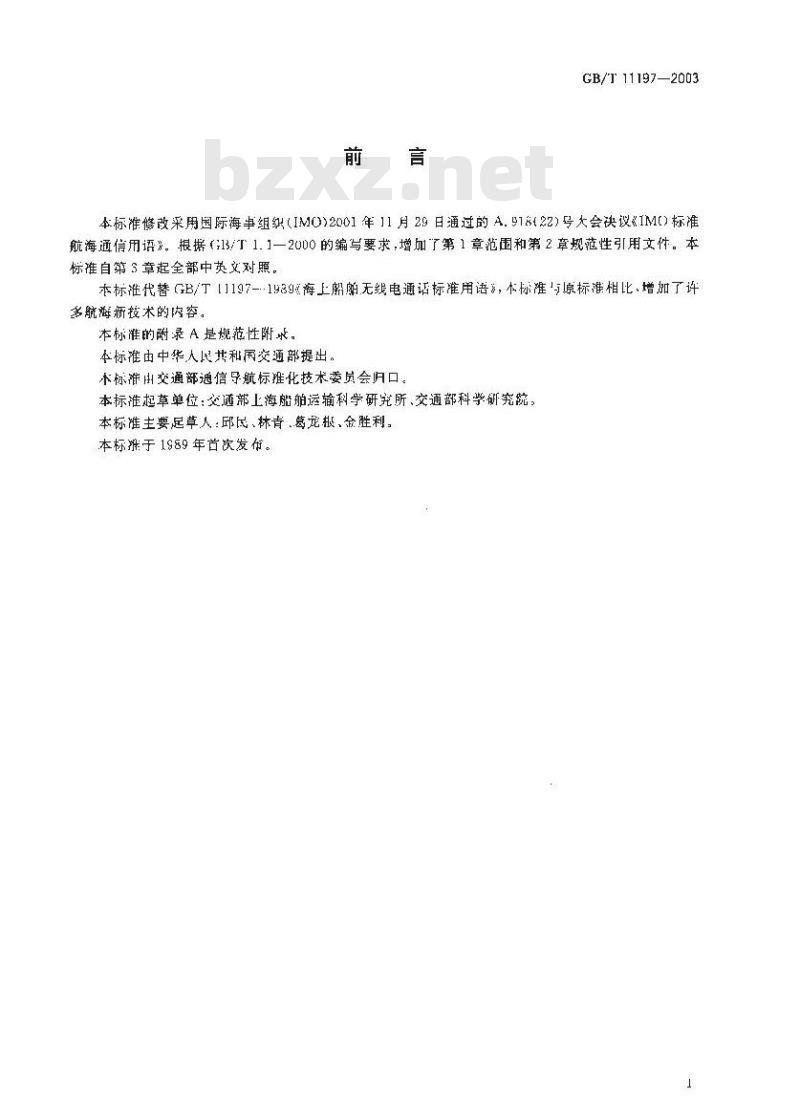
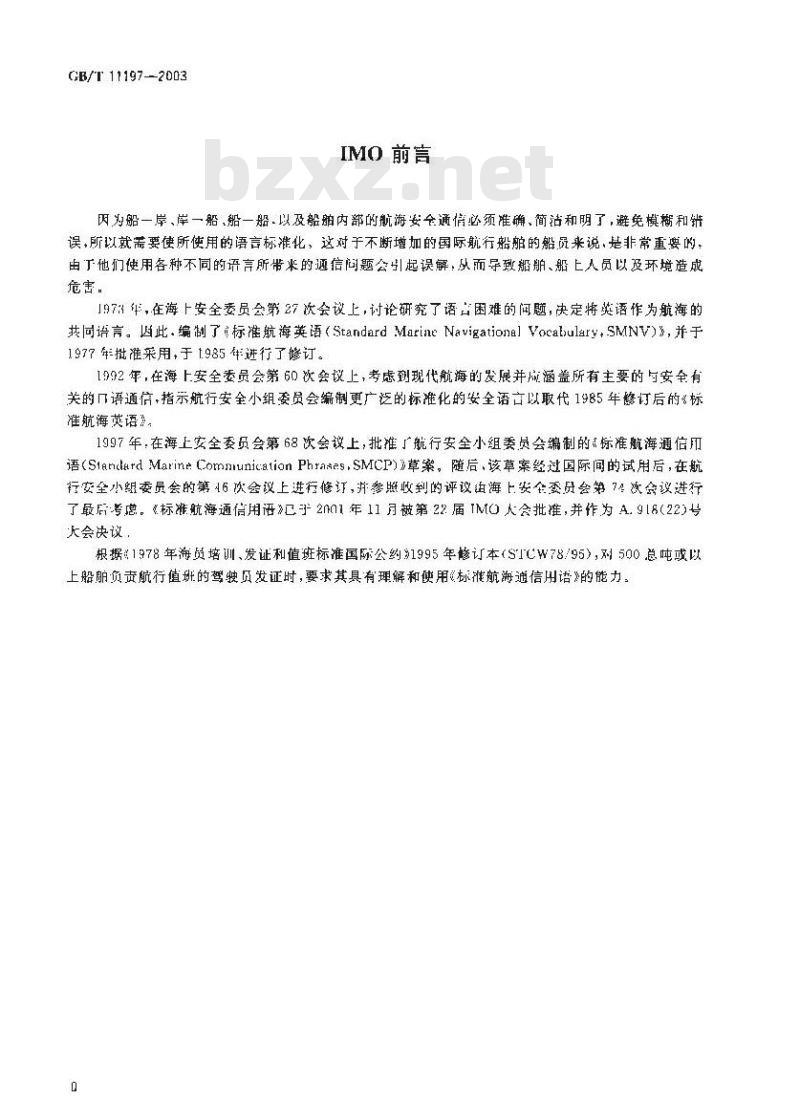
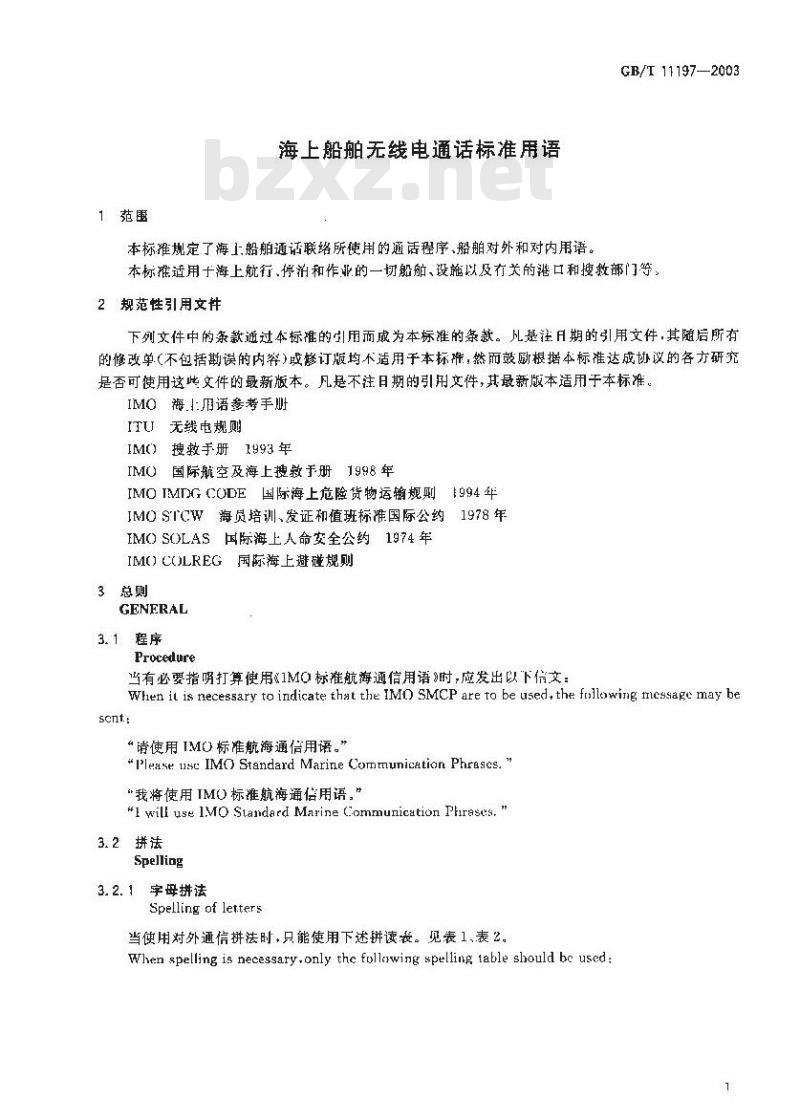
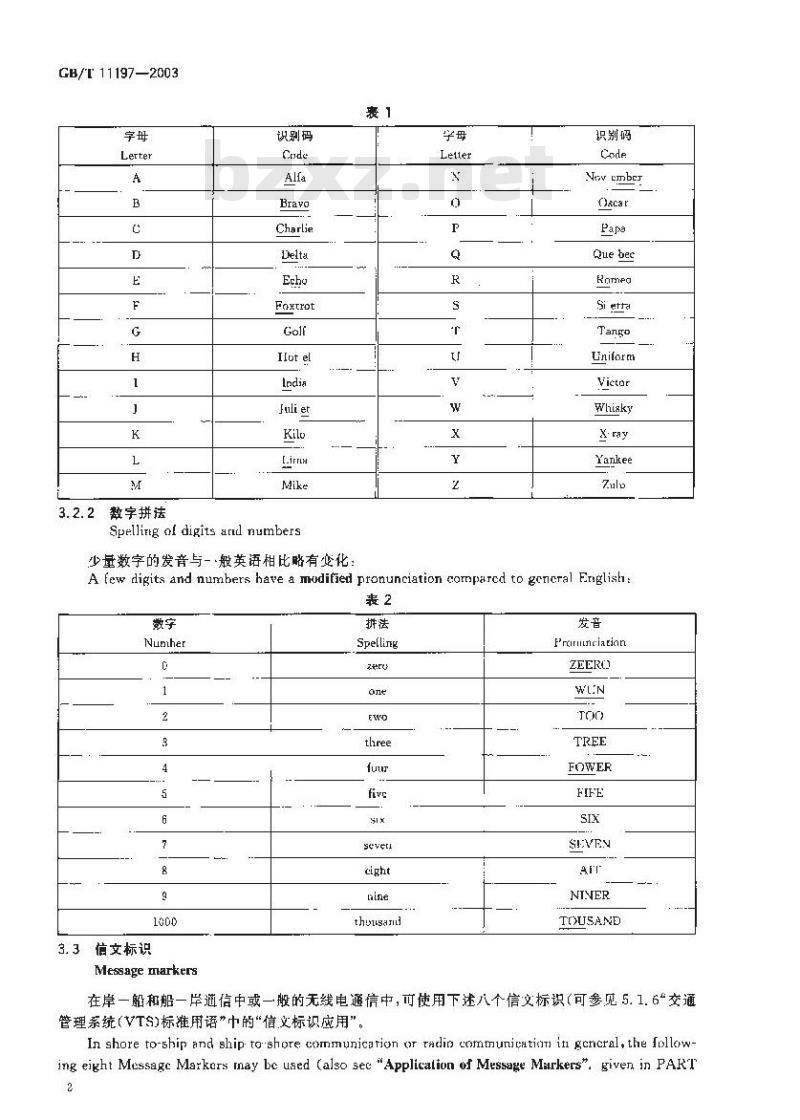
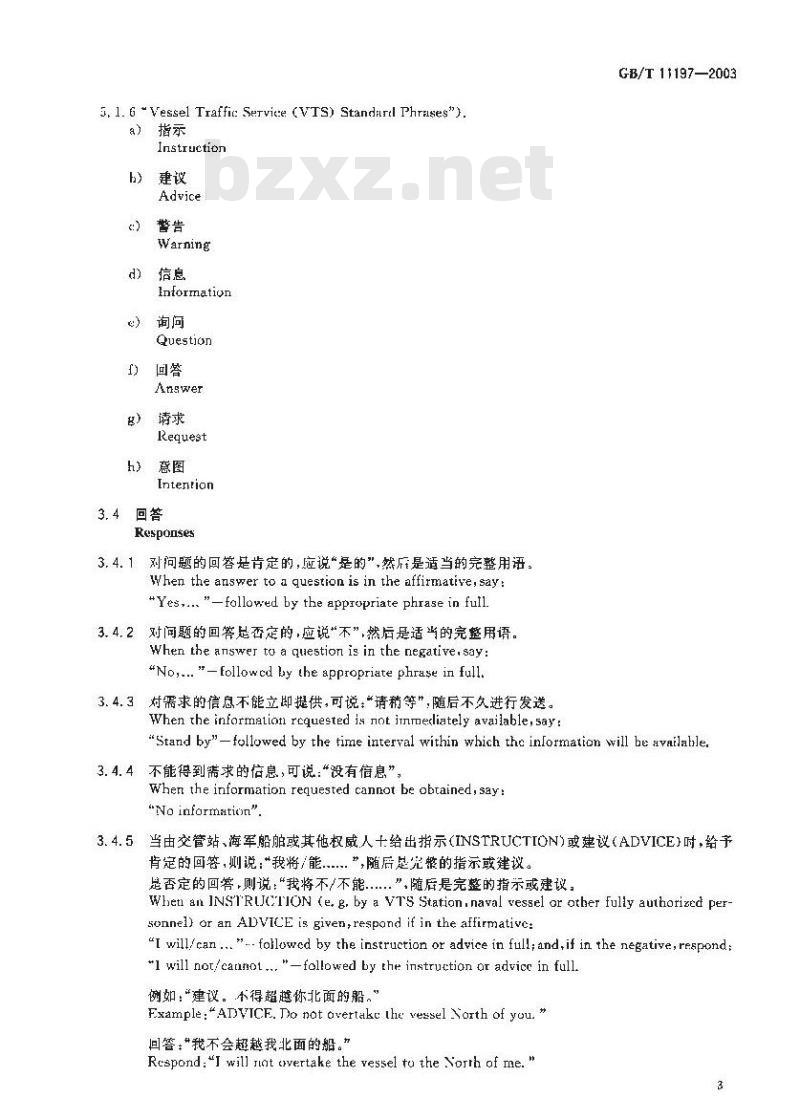
- 其它标准
- 热门标准
- 国家标准(GB)
- GB/T2828.1-2012 计数抽样检验程序 第1部分:按接收质量限(AQL)检索的逐批检验抽样计划
- GB/T29863-2023 服装制图
- GB/T228.1-2021 金属材料 拉伸试验 第1部分:室温试验方法
- GB50367-2013 混凝土结构加固设计规范
- GB5009.225-2023 食品安全国家标准 酒和食用酒精中乙醇浓度的测定
- GB/T18204.4-2000 公共场所毛巾、床上卧具微生物检验方法细菌总数测定
- GB/T23892.3-2009 滑动轴承 稳态条件下流体动压可倾瓦块止推轴承 第3部分:可倾瓦块止推轴承计算的许用值
- GB/T9145-2003 普通螺纹 中等精度、优选系列的极限尺寸
- GB/T11839-1989 二氧化铀芯块中硼的测定 姜黄素萃取光度法
- GB50209-2002 建筑地面工程施工质量验收规范
- GB/T7433-1987 对称电缆载波通信系统抗无线电广播和通信干扰的指标
- GB/T12053-1989 光学识别用字母数字字符集 第一部分:OCR-A字符集印刷图象的形状和尺寸
- GB5725-2009 安全网
- GB/T9239-1988 刚性转子平衡品质 许用不平衡的确定
- GB/T15917.3-1995 金属镝及氧化镝化学分析方法 对氯苯基荧光酮--溴化十六烷基三甲基胺分光光度法测定钽量
- 行业新闻
请牢记:“bzxz.net”即是“标准下载”四个汉字汉语拼音首字母与国际顶级域名“.net”的组合。 ©2025 标准下载网 www.bzxz.net 本站邮件:bzxznet@163.com
网站备案号:湘ICP备2025141790号-2
网站备案号:湘ICP备2025141790号-2